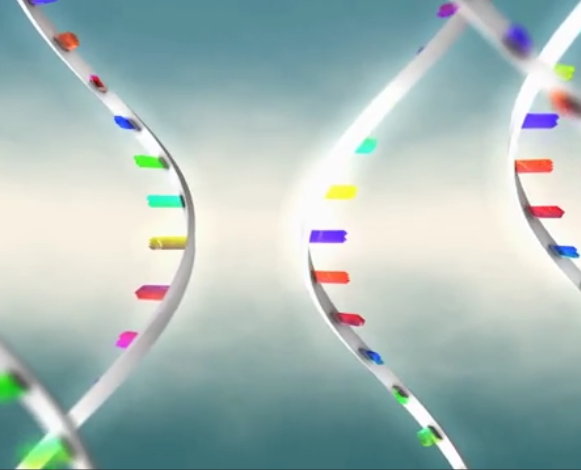IRP1 IRP2
The two proteins that act as sensors of iron changes in the cytoplasm, in duodenal epithelial cells, are the iron regulatory proteins, IRP1 (Iron Regulatory Protein 1) and IRP2 (Iron Regulatory Protein 2). The regulation of key enzymes involved in iron hemostasis, occurs at the translational level, through Iron Responsiv Element, i.e. regions of m-RNA involved in iron metabolism, and IRP proteins, which bind to IRE regions of m -RNA. Interestingly, IRP1 is an aconitase present in the cytosol; an identical aconitase is found in the mitochondrion, for the Krebs cycle, where it serves to convert citrate to iso-citrate.
This protein contains a prosthetic group with four iron atoms, 4 sulfur atoms, alternating at the vertices. It was discovered that the enzyme, in the cytoplasm, can lose an iron atom, changing from 4 to 3 iron atoms and becoming able to bind to m-RNA. This structure can give up iron when this is low, while when it is high it works as an aconitase; it can also give up iron when the level of ROS is high.

The enzyme is able to bind to a loop, a hairpin, of the m-RNA: this occurs when iron levels are low.
IRP2 also belong to the class of aconitases, although they never function as such, even when iron is high. In the latter condition, the protein is at low levels and is oxidized and degraded. Like IRP1, when iron is low it binds to m-RNA, although it does not lose iron from its structure, but is simply present at higher concentrations.
Whichever IRP it is, it binds to the m-RNA. This has loops, downstream or upstream of the coding region. When IRP binds on the 5'UTR side, it prevents the translation apparatus from working on the m-RNA, consequently protein synthesis will be inhibited. When IRP binds to the 3'UTR, the result is opposite, preventing the destruction of m-RNA by endonucleases: since the interaction side is at the 3', the synthesis will not be disturbed, but the synthesis will increase since the stability of the transcript increases.
The genes that are inhibited on the 3 UTR side are: the genes for the H and L subunit of ferritin (because in iron deficiency ferritin production is reduced), the enzyme ALA-Synthase that catalyzes the first step of the heme synthesis pathway (because if porphyrins do not bind to iron they are harmful), ferroporitin, the IF factor (sensitive to hypoxia) and the synthesis of mitochondrial aconitase. Thus, iron-using proteins are also inhibited. In general, the sense is to reduce the export of iron, already deficient in itself, in the tissues locally.
There are other IRPs, which bind to the 3'-UTR of certain m-RNAs, thereby increasing the production of transferrin and thus the mechanism for iron import and also the level of DMT1: the bivalent metal transporter, which is used to move iron out of/into the endosome.
If, on the other hand, iron is increased, the balance is shifted, IRP1 goes back to being an aconitase, and IRP2 is degraded; the IRPs break away from the m-RNA and what was being activated goes back to working less, while what was being inhibited is activated.
Alongside this rapid translational regulation, there is a transcriptional one that is much slower, but of longer duration. For example, under conditions of hypoxia or increased proliferation, the synthesis of the receptor for transferrin increases, because in apoxia, an attempt is made to increase oxygen uptake by increasing the production of hemoglobin, which requires more iron. Under conditions of increased proliferation, however, there is simply an increased need for protein. Exposure to cytokines increases m-RNA transcription for ferritin, thereby increasing ferritin levels.
To sum up:
IRP1 (Iron Regulatory Protein 1): IRP1 can act either as an iron-sulfur protein (a cytosolic aconitase) or as an IRE-binding protein, depending on the iron status of the cell. When iron levels are low, IRP1 binds to IREs to regulate iron metabolism. When iron levels are sufficient, IRP1 binds an iron-sulphur cluster and acts as a cytosolic aconitase, an enzyme involved in the citric acid cycle.
IRP2 (Iron Regulatory Protein 2): IRP2 also binds to IREs and regulates iron metabolism. Unlike IRP1, IRP2 does not have aconitase activity. It is regulated by proteasomal degradation in an iron- and oxygen-dependent manner.
Both IRP1 and IRP2 are crucial for the post-transcriptional regulation of a set of iron metabolic genes, including those involved in iron uptake (transferrin receptor), storage (ferritin), utilization (mitochondrial aconitase), and export (ferroportin).
![]() IRP1 IRP2
IRP1 IRP2 

